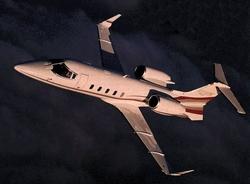Thu, Jul 23, 2009
System Cited In 2008 Accident In South Carolina
 In a letter to FAA Administrator
Randy Babbitt, acting NTSB chair Mark Rosenker is recommending that
the FAA require a re-design of the thrust reverser system on
Learjet 60 models.
In a letter to FAA Administrator
Randy Babbitt, acting NTSB chair Mark Rosenker is recommending that
the FAA require a re-design of the thrust reverser system on
Learjet 60 models.
The recommendation stems from a 2008 accident in South Carolina,
in which a Bombardier Learjet 60 operated by Global Exec Aviation
overran runway 11 while departing Columbia Metropolitan Airport in
Columbia, South Carolina. The pilot, copilot, and two of the four
passengers were killed. The two other passengers were seriously
injured, and the aircraft was destroyed by postcrash fire.
The letter states, in part:
"Postaccident examination of markings and tire debris indicated
that the right outboard tire failed first because of
underinflation, followed by failures of the other tires.2
Examination of the engines revealed evidence consistent with high
thrust in both engines and indicated that the thrust reversers were
stowed when the airplane hit the embankment.
In March 2009, Learjet published an FAA-approved temporary
flight manual (TFM) change in procedures, which described improved
methods for quickly recognizing and handling situations when
inadvertent stowage occurs. However, the NTSB is concerned that
Learjet 60 pilots are not sufficiently trained to recognize that a
failure could occur during takeoff as well as landing phases of
flight and could subsequently result in the loss of system logic
control requirements for maintaining deployed thrust reversers
during a rejected takeoff. The design of the Learjet 60 thrust
reverser system (and potentially similarly designed systems for
Raytheon Hawker 1000 business jets) is also of concern to the
NTSB."

Lear 60 File Photo
The NTSB has made the following recommendations in conjunction
with this incident:
- Require Learjet to change the design of the Learjet 60 thrust
lever system in future-manufactured airplanes so that the reverse
lever positions in the cockpit match the positions of the thrust
reverser mechanisms at the engines when the thrust reversers stow.
(A-09-55)
- Once design changes are developed per Safety Recommendation
A-09-55, require Learjet 60 operators to retrofit existing
airplanes so that the reverse lever positions in the cockpit match
the positions of the thrust reverser mechanisms at the engines when
the thrust reversers stow. (A-09-56)
- Require Learjet to develop and install improved aural or visual
cues on future-manufactured Learjet 60 airplanes that would allow
pilots to recognize an inadvertent thrust reverser stowage in a
timely manner. (A-09-57)
- Once improved aural or visual cues are developed per Safety
Recommendation A-09-57, require Learjet 60 operators to install
those cues on existing Learjet 60 airplanes. (A-09-58)
- Require that all Learjet 60 pilots receive training, for
takeoff as well as landing phases of flight, on recognizing an
inadvertent thrust reverser stowage, including the possibility that
the stowage can occur when the requirements for deploying thrust
reversers are not fully met, such as when the air/ground sensor
squat switch circuits are damaged. (A-09-59)
- Evaluate the design of the thrust reverser controls and
indications in Raytheon Hawker 1000 business jets for potential
thrust reverser failure modes that are similar to those identified
in Learjet 60 airplanes and implement necessary changes.
(A-09-60)
More News
Maximum Authorized Altitude A published altitude representing the maximum usable altitude or flight level for an airspace structure or route segment. It is the highest altitude on >[...]
Aero Linx: Soaring Safety Foundation (SSF) The Soaring Safety Foundation (SSF) is the Training and Safety arm of the Soaring Society of America (SSA). Our mission is to provide ins>[...]
From 2013 (YouTube Version): Dracula Lives On Through Kyle Franklin... and We're NOT Scared! ANN CEO and Editor-in-Chief, Jim Campbell speaks with Aerobatic and airshow master, Kyl>[...]
“For Montaer Aircraft it is a very prudent move to incorporate such reliable institution as Ocala Aviation, with the background of decades in training experience and aviation>[...]
Also: ForeFlight Upgrades, Cicare USA, Vittorazi Engines, EarthX We have a number of late-breaking news highlights from the 2024 Innovation Preview... which was PACKED with real ne>[...]
 ANN's Daily Aero-Term (04.14.24): Maximum Authorized Altitude
ANN's Daily Aero-Term (04.14.24): Maximum Authorized Altitude ANN's Daily Aero-Linx (04.14.24)
ANN's Daily Aero-Linx (04.14.24) Classic Aero-TV: 'We're Surviving'-- Kyle Franklin Describes Airshow Life 2013
Classic Aero-TV: 'We're Surviving'-- Kyle Franklin Describes Airshow Life 2013 Aero-News: Quote of the Day (04.14.24)
Aero-News: Quote of the Day (04.14.24) Airborne 04.09.24: SnF24!, Piper-DeltaHawk!, Fisher Update, Junkers
Airborne 04.09.24: SnF24!, Piper-DeltaHawk!, Fisher Update, Junkers




